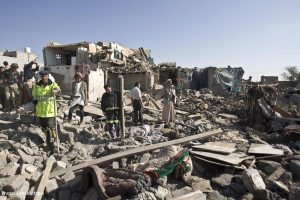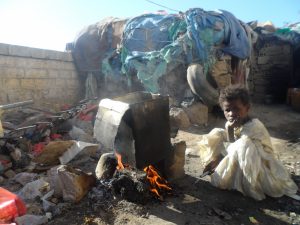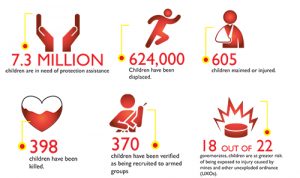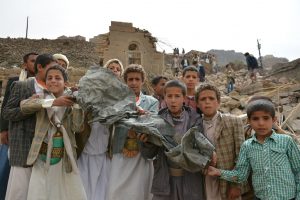Since 2014, Yemen has been in the grip of a humanitarian crisis due to indiscriminate attacks and bombing by governmental forces, Houthi rebels and the Saudi Arabian led coalition that are disproportionately affecting the country and its civilians on a daily basis.
With over 5,564 people having been killed since the outbreak of the crisis, more than half of whom are civilians, and a further 26,568 left injured, the humanitarian crisis in Yemen has reached epic proportions. The head of the International Committee of the Red Cross, Peter Maurer, said Yemen after five months of civil war looked like Syria after five years.

Understanding the conflict
The Republic of Yemen is a young country, having resulted from the 1990 unification of the Arab Republic of Yemen and the Democratic Republic of Yemen. Over the years, Yemen’s history has been troubled by rivalries between local tribes, the rise of secessionist movements, foreign interference and the presence of Al Qaïda on its territory, but since 2011, the situation in the country has gotten worse.
Unity within the country has been difficult to maintain as different groups have started to rise up against the government, especially the Houthi movement that led the former President Ali Adballah Saleh to flee the country and give up his functions in 2011. 
In 2012, he was replaced by President Adbo Rodo Mansour Hadi who plans to redraft the constitution and to divide the country into six regions. The Houthi movement, however, is demanding greater autonomy, and therefore disagrees with this project of his.
At the beginning of 2014, the Houthi movement launched different insurrections on the West Coast and in the South of the country. It finally came into possession of the capital in September 2014 and overthrew the government in January 2015. Since 2015 the Houthi movement has been in control of all of the Western part of Yemen, which is the most populated area of the country.
When the Houthis overthrew the government, President Mansour Hadi fled to Saudi Arabia. The following day, Saudi Arabia launched a military operation called “Decisive Storm”, led by a coalition made up of nine Arab States: Saudi Arabia, Egypt, Jordan, Sudan, Qatar, Bahrein, Kuwait, United Arab Emirates and Morocco.
Saudi Arabia’s intervention could be interpreted as being an attempt to protect its southern border with Yemen. However, its intervention should be considered from a global perspective. Indeed, Yemen is the pressure point within a kind of “cold war zone” opposing Saudi Arabia and the Islamic Republic of Iran. Iran is accused of providing material and supporting the Houthi movement while Saudi Arabia and Iran have been in opposition to one another for years; Yemen seems to be the perfect ground to put a stop any influence Iran has in this area.
All parties to the conflict have launched indiscriminate attacks against civilians as well as against civilian infrastructures. The situation has spiralled into a grave humanitarian crisis, which eventually led the UN in February 2015 to ask the parties to “immediately and unconditionally end violence and refrain from further unilateral actions that threatened the political transition”.
The Forgotten Humanitarian Crisis
Yemen, one of the poorest countries in the Middle East and also one of the poorest countries in the world, has now been afflicted by a serious humanitarian crisis for the past two years. Unfortunately, the Yemeni crisis has received very little attention in the media. The destruction of cities and basic infrastructure and the various restrictions and sanctions imposed by the Saudi-led coalition have led to over 21 million people being deprived of essential resources.
 The population of Yemen is 26.7 million. Out of this, 21 million people are in need of humanitarian aid, a figure that has gone up 33% since 2014. Yemen usually imports over 90% of its food; with the naval embargo and various sanctions only a fraction of imports are making their way through, which has led to severe food shortages and prices rises.In addition, fuel shortages and damage to markets and roads have made the distribution of food supplies difficult. Since the start of the civil war last year, over 12.9 million people are food insecure, while there has been a 52% increase in the number of those without access to safe drinking water or sanitation, with over 20 million people affected. This has led to an increase in the spread of waterborne diseases, such as cholera. Furthermore, sewage treatment plants and solid waste collection in many areas have ceased to work, which puts over 2.5 million children at of risk of diarrhoeal diseases.
The population of Yemen is 26.7 million. Out of this, 21 million people are in need of humanitarian aid, a figure that has gone up 33% since 2014. Yemen usually imports over 90% of its food; with the naval embargo and various sanctions only a fraction of imports are making their way through, which has led to severe food shortages and prices rises.In addition, fuel shortages and damage to markets and roads have made the distribution of food supplies difficult. Since the start of the civil war last year, over 12.9 million people are food insecure, while there has been a 52% increase in the number of those without access to safe drinking water or sanitation, with over 20 million people affected. This has led to an increase in the spread of waterborne diseases, such as cholera. Furthermore, sewage treatment plants and solid waste collection in many areas have ceased to work, which puts over 2.5 million children at of risk of diarrhoeal diseases.
The UN’s refugee agency, the UNHCR, has stated that more than 100,000 people have fled Yemen since late March 2015, of which 40,000 are Yemeni citizens while the rest are citizens of various countries in the Horn of Africa who were migrants and refugees in Yemen. The main countries that are currently hosting Yemeni refugees include Somalia where over 28,000 people have arrived, Djibouti, Saudi Arabia, and Ethiopia.
Children bear the brunt of the fights of adults in Yemen

Within the context of the armed conflict in Yemen, the victims are far more likely to be civilians—mostly women and children—than soldiers. Since the escalation of fighting in March 2015, children have borne the brunt of the armed conflict. According to the UN, 73% of child deaths and injuries during the second quarter of 2015 were caused by air strikes by the Saudi-led coalition, while 18% of child deaths and 17% of child injuries were attributed to Houthi forces. The UN estimates that around 747 children have been killed, while 1,108 have been injured, and over 724 have been recruited by armed forces and rebel groups during the armed conflict in Yemen.
At present, nearly 10 million children, which amounts to 80% of the country’s under-18 population, need urgent humanitarian assistance. The health system in Yemen has always been fragile, but the present shortages of medicines and medical supplies have left over 15 million people in need of basic health care.
According to a UNICEF report published in August 2015, around 590,000 pregnant women living in the most badly affected conflict areas are in greater danger of developing complications during pregnancy or childbirth as they are unable to access medical facilities. Additionally, across Yemen – in a series of attacks violating rules of international humanitarian law – hospitals and clinics have been attacked.
At present, 1.8 million children are already missing out on education, with the closure of at least 3,600 schools and damage to over 400 schools since March 2014. A further 346 schools are unusable: 23 have been occupied by armed groups, while 317 are housing internally displaced families.
The Response of the International Community
On 15 February 2015, the UN Security Council passed Resolution 2201, which condemned the Houthis’ takeover of the capital, Sana’a, in September 2014, demanded the withdrawal of their forces from governmental institutions, and called upon them to engage with the UN to support the political transition in a peaceful manner.
The UN then issued UN Security Council Resolution 2216 on 14 April 2015, which demanded an end to the violence in Yemen and established an arms embargo on the Houthis and forces loyal to the former President Saleh.
The intervention of the UN in Yemen has been criticised on several levels. Firstly, none of the Security Council Resolutions have been implemented in the country, neither by the Houthis nor by other parties involved in the conflict. Neither side has taken any measures to halt attacks on civilian areas nor to provide humanitarian assistance to vulnerable populations.
Furthermore, sanctions—including an arms embargo and a travel ban—imposed against Houthi leaders have not been put into effect. The arms embargo led to the Houthis takeover of the important harbour city of Aden; they now control the entry of goods, including medical supplies, food, and other necessary resources. The International Crisis Group noted in a report in March 2015 that the UN no longer had “sufficient leverage to encourage or enforce agreements”.
In addition, UN intervention has been directed only against the Houthis; the UN has not taken any measures against the actions of the coalition forces that regularly launch attacks in populated areas and against protected buildings. Finally, no measures have been taken to secure humanitarian assistance for affected civilians.
Major challenges
The armed conflict in Yemen risks becoming another proxy war between Saudi Arabia and Iran. Furthermore, fighting between the Houthi rebels and President Hadi’s governmentfurther threatens to divide the Yemini society along tribal and sectarian lines.
Lack of funding and access issues have affected the work of over 70 humanitarian organisations in Yemen. In April, Saudi Arabia pledged to support the UN’s appeal for $274 million, but no money has been received. In June, 2015 the UN launched a further appeal for $1.6 billion so as to provide humanitarian assistance to 11.7 million people. However, as of 19th August 2015 only 18% of this has been funded, which has forced UN agencies to borrow approximately $160 million from internal funds and reduce their operations.
The United Nations-brokered peace talks last month aimed at ending the war between the Houthi rebels and President Hadi’s government. However, the negotiations ended with no sign of a resolution to the conflict. UN special envoy Ismail Ould Cheikh Ahmed said the negotiations would resume on 14 January 2016.
In March 2016, UNICEF declared that 6 children are killed or harmed everyday in Yemen as a result of the conflict. Given the scale of the fighting coupled with the fact that there is no sign of any proper action coming from the international community, the humanitarian crisis in Yemen is only set to get worse, while thousands of children have already fallen victim to this conflict.
Written by : Priyanka Sinha & Claire Endberg March 2016 Proofread by: Hannah Brigit Maley |
http://www.ibtimes.com/yemen-crisis-death-toll-rises-saudi-arabias-allies-intensify-ground-operation-2150040
http://www.theguardian.com/world/2015/sep/03/banned-cluster-bombs-syria-ukraine-yemen-sudan-libya
https://www.rt.com/news/312891-yemen-syria-red-cross/
http://www.unhcr.org/55c0d5c09.html
http://www.un.org/press/en/2015/sc11781.doc.htm
http://english.alarabiya.net/en/News/middle-east/2015/03/23/Yemen-s-Hadi-calls-for-GCC-military-intervention.html
http://www.un.org/press/en/2015/sc11859.doc.htm
http://www.crisisgroup.org/~/media/Files/Middle%20East%20North%20Africa/Iran%20Gulf/Yemen/b045-yemen-at-war.pdf
http://www.irinnews.org/report/102010/is-yemen-europe-s-next-migration-crisis
http://www.yemenpost.net/Detail123456789.aspx?ID=3&SubID=8354&MainCat=3
http://www.bbc.com/news/world-middle-east-34011187
http://www.unicef.org/media/files/CHILD_ALERT_YEMEN-UNICEF_AUG_2015_ENG_FINAL.pdf
http://reliefweb.int/sites/reliefweb.int/files/resources/Nowhere_Safe_for_Yemens_Children.pdf
http://www.aljazeera.com/news/2015/12/yemen-peace-talks-called-clashes-151220141116705.html
http://www.savethechildren.org/site/c.8rKLIXMGIpI4E/b.6153153/k.BDE3/Yemen.htm
http://www.unicef.org/french/media/media_82940.htmlhttps://www.unicef.fr/contenu/espace-medias/yemen-les-enfants-au-bord-du-chaos-face-au-risque-d-effondrement-du-pays


